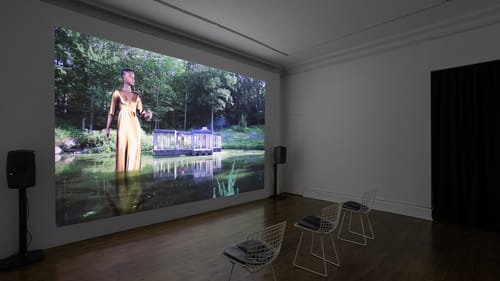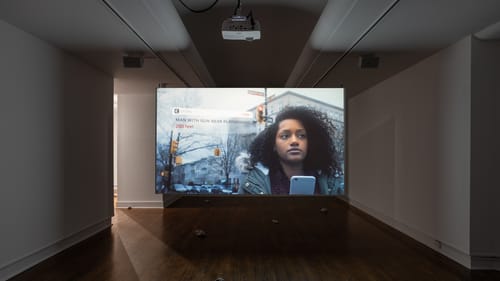Stay in the Loop
BSR publishes on a weekly schedule, with an email newsletter every Wednesday and Thursday morning. There’s no paywall, and subscribing is always free.
Our convulsive moment
Art Alliance at UArts presents New Typologies

New Typologies, a mosaic of work by David Hartt (b. 1967), James Hoff (b. 1975), and Kahlil Robert Irving (b. 1992) surveys this convulsive moment in video, sound, collage, painting, and sculpture. It’s on view at the Art Alliance galleries of University of the Arts.
Hartt, Hoff, and Irving document social and political struggles that have come to a boil in the last decade, spinning a tsunami of protest, challenge, and interrogation into a re-examination of assumptions and expectations. Aerial and on-the-ground views are juxtaposed, compelling viewers to confront beliefs: onlookers are transformed into participants, and observation into commentary.
The exhibit challenges, and at times assaults, the senses: can you follow Charles Barnett’s meandering memories in Hartt’s video On Exactitude in Science (Watts) (2021)? Do you spy the detail in Irving’s intricate collages and sculpture? Are you nimble enough not to stumble on Hoff’s scattered rocks in 2022’s Light Cycles (Various)? And will you withstand the sensory onslaught of Hoff and DeForrest Brown Jr.’s hurtle through decades of racial flash points?
Revisiting Watts
Hartt, an associate professor in fine arts at University of Pennsylvania, leads off the exhibition with On Exactitude, which revisits Watts through the eyes of Barnett, a filmmaker. Long one of Los Angeles’s most impoverished areas, the neighborhood gained national attention in the 1960s for fiery rioting that grew from a police confrontation with a young Black man. That may be all many know of Watts. Hartt expands the perception, illustrating Barnett’s voiceover with vintage and current glimpses of homes, stores, and local landmarks, deftly interspersing views of a cloudless blue sky, which looks the same from everyone’s backyard.

Social sediment
On a nearby wall hangs Irving’s digital collage, which is as layered as its title: Screen Shot Charts: {from Ming to Ebay, and google scrolls (mixed micro Messages (DMs)* 1} (2018). It’s a compendium of 40 years of media images, filtered through the consciousness of a young Black man, compressed into a frame that fits over a sofa.
Irving, who teaches at Maryland Institute College of Art, is concerned with the prevalence and impact of digital culture. Screen Shot is a digitally sourced time capsule. There’s a scene from the 1970s TV series Good Times, in which the family laughs together in their kitchen, overlaid with a picture of a white woman saying, “I heard one of them talking about dynamite.” From Instagram, a picture of a grandmotherly woman holding a graduation portrait of murdered Eric Garner. Ads are connective tissue—packaging from Camel cigarettes and Cherry Coke, movie posters, album covers, and another tattling white woman, this time saying, “Hello police…Never mind.” At center, a microscopic timeline traces the years 1625 to 2017, which Irving has divided into periods of slavery (265 years), segregation (99 years), and freedom (52 years) with the comment, “Stop saying people should just get over it…when this is the history of African Americans in this country.”
Irving’s sculpture STREET MASS (flags & towers) Mixedskies & Grounds (2019-2022) is a two-foot tower that leans ever so slightly, topped by an uneven, rocky roof that looks like a seam of coal. Its sides are papered with detritus you’d find on the ground or stuck in a desk drawer—membership cards, a print ad for Bud Light, an American flag picture, a newspaper clipping about Allen Iverson winning the 1997 NBA Rookie of the Year, a screenshot of a chat about diversity, and a tiny photo of the artist.
Ambivalent landscapes
Hoff creates burnished landscapes using circuit-board technology, etching trees into copper and fiberglass. The process yields warmly reflective surfaces with a dot-matrix texture, as though seeing the forest through a fine screen. Many are on view, classified as “obsolete” or “useless,” depending on the vantage, asking the question, according to whom?
Obsolete Landscape 1 (2022) is a quiver of pines in the mist, viewed from a mountaintop. Sharp branches in the foreground soften as they recede into the atmosphere. Though it could be a low cloud or fog, the coppery tone makes it impossible not to think of wildfire-choked skies smothering the treetops. In Useless Landscape (2022), Hoff lowers us to the forest floor, among spindly trees too thin for logging, but just right for kindling.
As co-founder of Primary Information, which publishes new and out-of-print books by artists, Hoff frequently challenges conventional wisdom about what’s obsolete and useless. By preserving artists’ voices and keeping their writing affordably in print, Primary Information maintains the relevance of the creative view, irrespective of the judgement of big media.
Divergent videos
Videos by Hoff and Hartt anchor the Art Alliance’s second floor. Nothing prepares a viewer for HOBO UFO (v. The New World) (2020), but a clue is the warning posted for those prone to photosensitive seizures. The 19-minute video by Hoff and composer Brown begins with calm interiors of the White House, and quickly accelerates to Google Earth views of Charleston, South Carolina, streets, a New York City 911 dispatch center, and “dangerous person” warnings bubbling up from smart phones, sent by a citizen alert application. There’s 1964 footage of police dogs and fire hoses being turned on civil-rights protesters. It’s all loud and rapid-fire. Then the screen goes black, and a voice repeats familiar names: Rodney King, Trayvon Martin, George Floyd, and more. Later, audio of a Black Lives Matter speaker admonishing whites who did nothing in the face of injustice, and Blacks who moved away to avoid confrontation. We hear 114 Black people have died at the hands of police since Covid-19 began, and see the names scroll by. HOBO UFO is disorienting, dismaying, and heartbreaking.

At the opposite end of the gallery, insulated from the tumult of HOBO UFO, is Hartt’s Et in Arcadia Ego (2022), a reworking of the Arcadian myth. The video, filmed at architect Philip Johnson’s Glass House, features the video’s composer Tomeka Reid as a towering Olympia. In it, Hart considers the evolution of Johnson’s image as his connections to fascism and anti-Semitism became known.
Seeing the world better
Hartt’s practice focuses on how concepts change and persist over time, a common theme across the exhibit. In 2018, he said, “One of the unique capacities of art is that it allows us to address unstable concepts and to dimensionalize them, and I have a firm belief that through making work, I see and understand the world better.”
He might have been speaking for people who view art as well.
What, When, Where
New Typologies: David Hartt, James Hoff, Kahlil Robert Irving. Through December 15, 2023, at University of the Arts Art Alliance, 251 South 18th Street, Philadelphia. (215) 545-4302 or uarts.edu/centers/artalliance.
Accessibility
Masks are optional inside the galleries.
The Art Alliance is housed in a historic building with limited accessibility. Wheelchair access is not available. There are stairs at the entrance and between floors. The University of the Arts is currently raising funds to make the venue accessible and ADA compliant, and regrets that improvements are not in place for current exhibitions. Please direct accessibility questions to [email protected].
Sign up for our newsletter
All of the week's new articles, all in one place. Sign up for the free weekly BSR newsletters, and don't miss a conversation.
